The American Dental Association (ADA) and the American Association of Orthodontists (AAO) recommend that young patients get an orthodontic evaluation at 6 or 7 years of age.1, 2 An early orthodontic check-up enables clinicians to spot current or potential problems with their patient’s occlusion and jaw growth. This can especially be valuable for Class III patients.
If the doctor sees orthodontic issues like Class III, posterior crossbite, open bite, deep bite, and oral habits early, he can provide interceptive orthodontic treatment to guide proper craniofacial development. This early guidance can often be simple for the clinician to do and can create better anatomical relationships for when permanent teeth erupt. Permanent teeth can then be straightened with comprehensive orthodontics at that time, if desired. This mixed dentition type of treatment gives many patients the best chance towards a full correction.
For certain cases (like some severe Class III, cross bite, and thumb sucking cases), full corrections can only be possible with early intervention or more invasive orthognathic surgery. Since interceptive orthodontics can be less invasive, faster, and cheaper for the clinician and the patient, dentists and orthodontists should have an understanding of what to look for in their young patients to provide the best level of care.
Class III Growth Pattern Difficulties
Dentists usually agree that Class III cases are some of the trickiest to correct because of their adverse growth characteristics.
In various studies, it has been shown that Class III malocclusions worsen for individuals during key growth stages during childhood and adolescence. In the Wolfe et al. 2 studies, the maxillomandibular discrepancy of untreated Class III patients got progressively more disparate in subjects between 6 and 16 years old. Class III individuals accumulate greater anteroposterior (AP) growth excesses over this time with larger more protrusive mandibles and smaller maxillas compared to their Class I counterparts. Class III subjects in the study showed a large maxillomandibular differential and small Wits differential, which worsened as they grew.3
There is also extensive growth research done by Donald B. McGann who looked at differential horizontal growth (DHG) from 265 untreated growing patients from Burlington and Bolton Brush untreated samples. Although not all his research has been published, he found the DHG and Wits angles and norms of different case types. From his DHG analysis, doctors can assume that for every 1 millimeter that the maxilla grows, the mandible will grow around 1.2 to 1.5 millimeters if the mandible is left untreated and unchecked with proper occlusion.
Class III patients have unfavorable growth characteristics. If no intervention is done during their growth spurt, you can expect their malocclusion to worsen with time. Luckily with very early orthodontic intervention, we’ve seen that full dental Class III corrections can be made and this normalization will retain during future growth.
Timing is Everything
If a dentist does an orthodontic evaluation on a young, Class III patient, they may be able to use the child’s growth to their advantage. Various interceptive orthodontic treatment and appliances have been used to prevent or fix the growing antero-posterior (AP) discrepancy in young patients. Early treatment can easily help Class III patients achieve a more balanced craniofacial relationship.
Appliances like reverse headgear (protraction facemask) therapy can change the direction of growth of the mandible to help the bite relationship. Clinicians can often fully correct a Class III case with maxillary insufficiency if intercepted soon after the upper and lower incisors erupt (around ages 7 to 8 years old). Protraction facemask therapy used at this time can create a positive overjet with relatively stable results, even when the mandible grows. This therapy is ideal to start when the maxillary incisors erupt, before the Class III malocclusion is fully experessed.4
During kids’ first orthodontic evaluation (ideally at 6 or 7 years old), dentists and orthodontists can better understand the individual’s growth stage (and their expected future remaining growth). Through the growth research findings from Grave et al 5 it is recommended that clinicians include growth analysis when a patient has malocclusions. If a dentist notices that the patient has Class III tendencies, he should take a lateral ceph to assess their skeletal relation and get study models to measure if the patient has transverse issues. He should also look at the occlusion to see if the patient is also dental Class III or may have posterior cross bite. Understanding these characteristics will help general dentists to better treat (or refer) patients appropriately, at the right time.
Clinicians’ growth analysis and orthodontic evaluation can help determine the most efficient time to start treatment for Class II and III patients, reducing the time and cost needed for interceptive appliance use, and giving the greater possibility of a full correction without surgery.5
A Viable Alternative for Full Correction
Longitudinal studies show that with time, untreated Class III cases get progressively more Class III and delayed treatment makes it more difficult to achieve full corrections without orthognathic surgery. While most severe Class III patients are recommended to get orthognathic surgery, many patients choose against this since they could have long recovery times, a high cost, and pain. If surgery is not a viable option for them, these Class III patients often choose to do nothing, which negatively affects their dentofacial function, self-image and aesthetics dramatically.
An alternative treatment option (if evaluated early), is interceptive orthodontic treatment. This can reduce the DHG and large bite discrepancy for young Class III individuals. Common appliances and treatment often include reverse headgear or other types of protrusive facemask therapy. Class III interceptive orthodontic treatment is often simple to do with some training and support. General dentists and pediatric dentists can evaluate and treat these cases themselves or refer them to an orthodontist.
Case Presentation
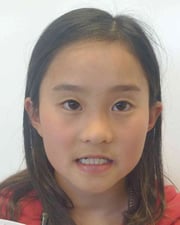 |
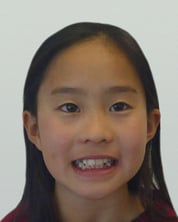 |
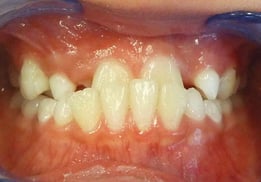 |
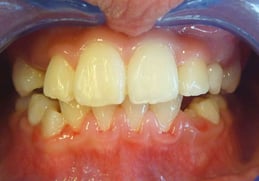 |
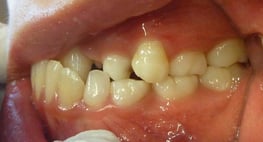 |
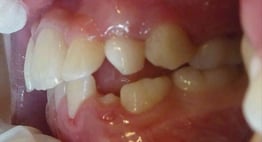 |
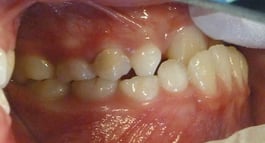 |
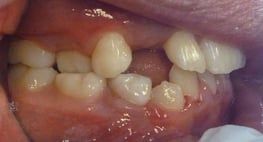 |
This 9.5 year old patient presented severe Class III and extreme AP discrepancy. Her family knew her bite was not right and was concerned about how it would progress. Since they did not want her to go through surgery (as her previous dentist recommended), they sought a second and third opinion. In her third opinion, Dr. Christopher Lee considered surgery but ultimately recommended to use Jane’s growth early in two phases to fix her severe maxillo-mandibular Class III relationship.
The first phase of mixed dentition treatment included daily use of reverse headgear for 6 months and a nickel-titanium open coil to make space for her erupting upper lateral incisors. Pink filling composites were also used to disclude Jane’s bite. 016N and 18x25 heat activated niti wires were also used to help with tooth alignment. Phase I treatment, before the eruption of secondary teeth, was used to fix her malocclusion and AP relationship during 9 months within an important stage of her growth.
The bite was corrected from a Class III functional anterior crossbite to having good overbite and overjet. With a dramatic improvement of her overjet, her jaws and muscles adjusted to the correct occlusal placement. When she experiences more craniofacial growth during adolescence, her bite has a greater chance to stay in its proper occlusion. Full braces were not used during this Phase I stage. In a few years after her permanent teeth are all in, Jane will go into full braces in the second phase of treatment to straighten her teeth and evaluate for possible surgery if facial esthetics are unacceptable.
Conclusion
Although this case shows impressive improvements within a reasonable amount of time, it could have been more ideal. An earlier start date and/or more regular headgear use could have reduced the Phase I treatment time but the patient had a different doctor when her incisors erupted. Despite these setbacks, the patient has a much improved bite relationship from this non-invasive, favorable treatment.
Evaluating and treating Class III patients early (when their secondary incisors erupt) can significantly improve malocclusions over delayed or forgone treatment. It is important for dentists to know when and how to look for these patients, as they benefit most during this growth period. While later treatment can still improve the Class III malocclusion of these patients, delayed non-surgical treatment may take longer, cost more, and be less effective.
Acknowledgements
A special thanks goes out to Dr. Christopher Lee (a graduate from our Melbourne Comprehensive Orthodontic program) for sharing the Phase I treatment of this case presentation. Thanks also goes out to Progressive Orthodontic Seminars instructor, Dr. Campbell Roberts, who provided instructor online diagnosis guidance for this case.
As a global orthodontic education center with a growth curriculum, we worked with Head Instructor and Founder, Dr. Donald B. McGann, and Educational Director, Dr. David Dana, on this article. Additional acknowledgment goes to tenured instructor, Dr. Shockley Wier, and statistician Jermi Leasure, who contributed to Dr. McGann’s extensive growth research study.
References
- The Right Time for an Orthodontic Check-Up: No Later than Age 7. American Association of Orthodontists. https://aaoinfo.org/system/files/media/documents/Right_Time_for_Ortho-MLMS-hl.pdf. Accessed June 6, 2016.
- When should I take my child to see an orthodontist? Sharecare.com. https://www.sharecare.com/health/orthodontic-braces/when-take-child-to-orthodontist. Accessed June 7, 2016.
- Wolfe SM, Araujo E, Behrents RG, Buschang PH. Craniofacial growth of Class III subjects six to sixteen years of age. Angle Orthodontist. 2011; Vol 81 No 2.
- Ngan P. Early treatment of Class III malocclusion: Is it worth the burden? American Journal of Orthodontics and Dentofacial Orthopedics. 2006: Vol 129, No 4, Supplement 1.
- Grave K, and Townsend G. Hand-wrist and cervical vertebral maturation indicators: How can these events be used to time class II treatments? Australian Ortho Journal. November 2003; 19:33-45.
- Lee C. Stories. Progressive Orthodontic Seminars. http://posortho.smilestream.com/pos-stories. Accessed June 6, 2016.


